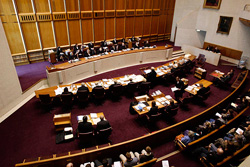This page has moved ...
Some sites on the Internet are still linking to this page.ÂÂÂÂ Please follow the link below for the latest employment information.
http://www.hcourt.gov.au/employment
ÂÂ
The High Court building is one of Canberra's major tourist attractions and is situated in the Parliamentary Zone in Parkes Place Parkes, on the shores of Lake Burley Griffin between the National Science and Technology Centre (Questacon) and the National Gallery of Australia. The High Court-National Gallery precinct was added to the National Heritage List in November 2007.
The building is a unique structure. Forty metres tall and constructed mainly of concrete and glass, it has four main elements: a large public hall, three courtrooms, an administrative wing, and Justices' chambers. Public visitors may view:
- the Great Hall, which includes an educational display and video area, and often features exhibitions or performances by cultural organisations; and
- the three courtrooms, which are the focus of the building's activities.
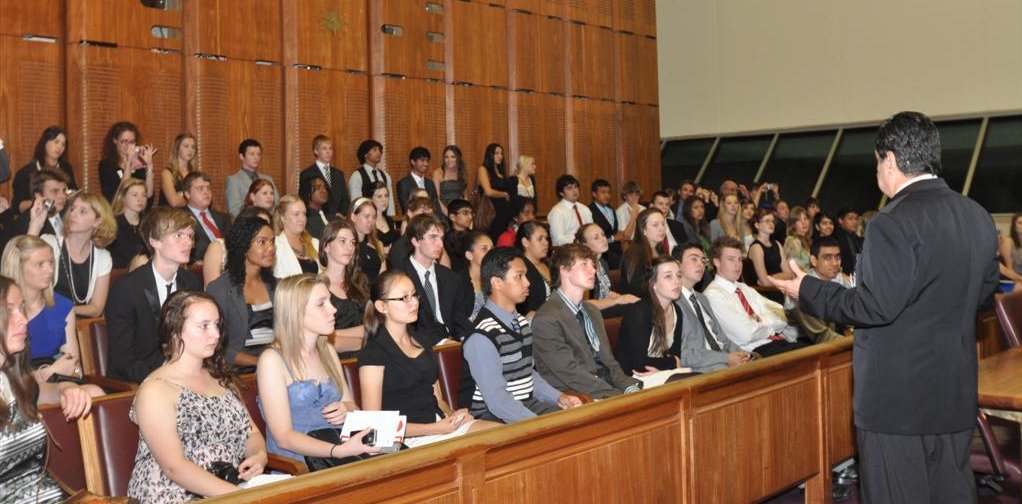 Court Guides are on hand to introduce you to history, role and operation of the High Court and its building.
Court Guides are on hand to introduce you to history, role and operation of the High Court and its building.
Please check the Court Calendar before planning your visit. If the Court is sitting, you are welcome to watch proceedings. We request your cooperation in respecting Court etiquette when watching proceedings.
The building is surrounded by parkland which provides an ideal venue for lunch on fine days. Many school groups bring their lunch and enjoy it on the shores of the lake.
Court Sittings and Building Opening Hours
The calendar of Court sittings is determined by the Court and is usually published in the September prior to the start of each year. See the Court Calendar.
Normally, the Court sits in Canberra for two weeks of every month, except for January and July when it is in recess. High Court sittings are open to the public. Normal Court sitting hours are from 10.00 am to 12.45 pm and 2.15 pm to 4.15 pm.
The building is open to the public from 9.45 am to 4.30 pm Monday through Friday, except public holidays. Admission to the High Court building is free of charge.
When you visit the High Court we request your cooperation in respecting Court etiquette and Building Conditions of Entry.
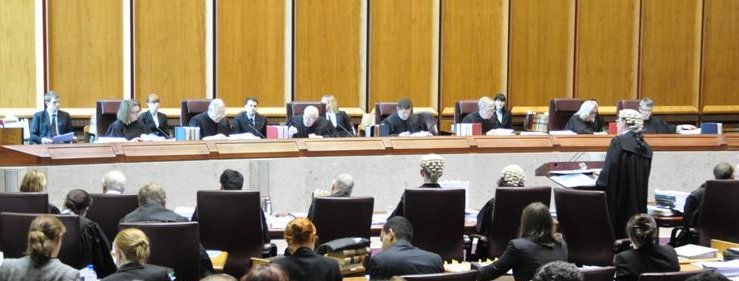
Booked tours
Bookings are essential for groups of visiting school students or other organised tours. Please visit our tour bookings page to access the online booking system, risk assessment and insurance certificate.
Independent visitors do not need to make a booking.
Talks by Court Guides
Visitors are welcome to visit the building at any time during ordinary opening hours. A Court Guide is available in each courtroom to provide information about the history, role and function of the High Court and its architecture. On sitting days, visitors are welcome to view the sitting Court.
Please consult the Court calendar for the sitting schedule.
Accessibility statement
The Court is committed to making our building and events accessible to all visitors. A range of services are available to facilitate your visit to the building.
Public entry into the building is through the Level 2 forecourt entrance, situated at the top of the ceremonial ramp from King Edward Terrace, and between the National Portrait Gallery and the National Gallery of Australia. The accessibility entrance is located at the Ground Level of the building, via Parkes Place East. Accessible drop-off and pick-up spots are located on Parkes Place East. Please ring the accessibility bell for assistance. All visitors are required to go through security screening.
Public areas of the building are accessible to all visitors. Wheelchair and motorised scooter users are required to access the five public levels via the lifts.
Accessibility toilets are located on Level 1, passed the Australian Constitution Centre exhibition.
Trained assistance animals are welcomed when accompanied by their handler.
Our friendly Court Guide team is available to answer any of your pre-visit questions, please email This e-mail address is being protected from spambots. You need JavaScript enabled to view it or call 6270 6998.
- Introduction
- Structural features
- Evolution of construction of the building
- Design concept and architectural rationale
- The Public Hall
- Courtroom 1
- Courtroom 2
- Courtroom 3
Oral History Podcast of the 40th Anniversary of the High Court Building
An oral history project was commissioned to celebrate the 40th anniversary of the opening of the building of the High Court in Canberra. The High Court is a unique and architecturally significant building. Its design was the culmination of an international competition and its construction took place between 1976 and 1980. Its interior design, artworks and furnishings were integral to the effort to construct a building for the nation which reflected the significance of the High Court at the apex of the judicial branch of government.
This project resulted in a series of four podcasts focused on the construction phase of the building, its opening, and the experiences of and challenges faced by the architects, engineers, designers and artists in that phase of the building’s history.
The collaborative team of Emma Russell, History At Work; Bryce Grunden, Sound Environment; David Huxtable, LookEar; and Leo Martin, Line Of Sight Heritage conducted the research, oral history, script writing and podcast production.
Part 1: The Vision: This podcast is about the inspiration and the drive behind the decision to provide the High Court with its own magnificent building in the capital.
Part 2: The Debate: It is not possible to have a building of this stature and significance without debates and challenges associated with it. This podcast explores the concerns and protests associated with the construction and opening of the High Court.
Part 3: The Artistry: This podcast enters the studios and workplaces of some of those responsible for the magnificent artworks that were commissioned for the High Court.
Part 4: The Vibe: After all the planning, construction, artistry, symbolism, debates and challenges has this building stood the test of time for its users, the public, its purpose and its role and has its vision been achieved and appreciated? This podcast asks what people feel about the High Court building.
“Remarks by Feiko Bouman at the Launch of the Oral History Podcast”, 19 May 2021, High Court Canberra. (DOC)
Introduction
 The High Court building is an outstanding example of late modern Brutalist architecture. It has light-filled, bold geometric shapes and spaces, raw massed concrete, dynamic internal movement, and strong links with neighbouring buildings and landscape. It is monumental and asymmetrical, but also functional.
The High Court building is an outstanding example of late modern Brutalist architecture. It has light-filled, bold geometric shapes and spaces, raw massed concrete, dynamic internal movement, and strong links with neighbouring buildings and landscape. It is monumental and asymmetrical, but also functional.
A national design competition for the building announced in May 1972 was won by the architectural firm of Edwards Madigan Torzillo and Briggs (EMTB). EMTB was also responsible for the adjacent Australian National Gallery (as it was then) and links. EMTB Director and architect Christopher Kringas led the design of the High Court, working closely with Feiko Bouman and Rod Lawrence. Kringas died in 1975, just prior to construction. Colin Madigan, who was the team leader for the National Gallery, and Hans Marelli, oversaw the construction phase of the High Court building.
The competition brief called for a monumental building that acknowledged, but was clearly independent of the Australian Parliament. The location of the Court relative to the Australian Parliament demonstrates the separation of judicial power from executive and legislative power.
The assessment panel for the design competition entries comprised Chief Justice Sir Garfield Barwick GCMG, the Commissioner of the National Capital Development Commission Sir John Overall, the chair of the Australian Universities Commission, Peter Karmel, New South Wales Government Architect, EH Farmer, and Melbourne architect Daryl Jackson.1 More than 150 designs were entered in the competition.
The High Court–National Gallery Precinct was entered on the National Heritage List in 2007. The High Court building is also listed on the World Register of Significant 20th Century Architecture. In 2007 it received the Royal Australian Institute of Architects National ‘25 Year Award for Enduring Architecture’.It is situated on 3.4 hectares (8.4 acres) of land in the Parliamentary Triangle, on the shores of Lake Burley Griffin between the National Science and Technology Centre and the National Gallery of Australia.
The builder, PDC Constructions (ACT) Pty Ltd, began construction of the building in 1975, and it was completed in 1980 at a total cost of $46.5 million. It was officially opened by Her Majesty Queen Elizabeth II on 26 May 1980.
Structural features
The 40-metre tall building is essentially one of concrete and glass comprising a number of major functional elements, namely a large public hall, three courtrooms, an administrative wing, and Justices chambers.
The forecourt and main entrance of the building are approached via a long, paved ceremonial ramp underneath which is a car park, warehouse and machinery rooms. A waterfall, designed by Robert Woodward and constructed of South Australian speckled granite, runs the full length of one side of the ramp.
Most of the external and internal walls created by the 18,400 cubic metres of concrete used in the construction have been subjected to a process known as "bush hammering", carried out with a percussion instrument, which has flaked the surface and exposed the aggregate within the concrete.
The glazed areas total some 4,000 square metres and these are mainly on the northern and southern faces of the building. The use of steel frame supports for the glazed areas has meant that generous expansion allowances have had to be provided to cope with Canberra's relatively wide temperature range. A system was devised so that the glass in the walls can "creep" up or down according to the temperature changes and any movement in the concrete structure.
The internal floor area of the building is approximately 18,515 square metres. The building itself covers 0.32 hectares (0.8 acres) and is surrounded by nearly 1 hectare (2.5 acres) of quarry tiles.
Evolution of construction of the building
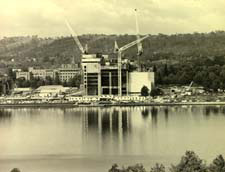 The Federal Government approved the transfer of the High Court to Canberra in 1968. (Since 1973, the Court's Principal Registry had been located in Sydney, and for 45 years prior to that it had been in Melbourne). The National Capital Development Commission (NCDC) was authorised to initiate design studies for the building at a lakeside site within the Parliamentary Triangle.
The Federal Government approved the transfer of the High Court to Canberra in 1968. (Since 1973, the Court's Principal Registry had been located in Sydney, and for 45 years prior to that it had been in Melbourne). The National Capital Development Commission (NCDC) was authorised to initiate design studies for the building at a lakeside site within the Parliamentary Triangle.
In 1972 the NCDC completed its design studies and recommended a precise site for the building. The Government approved the site and at the same time asked the NCDC to conduct an architectural competition for the design of the building.
A total of 158 designs were eventually submitted in the competition. In December 1972 a committee of assessors carried out preliminary adjudication of the designs and reduced the number to 9. From these, a list of 6 finalists was chosen in January 1973.
The finalists were then briefed further about the design intentions for the building and given until July 1973 to flesh out their original proposals to incorporate these intentions.
In October 1973 the Prime Minister, Mr Whitlam, announced the winning design, submitted by the Sydney firm of Edwards Madigan Torzillo and Briggs Pty Ltd.
In mid-1974 the NCDC advertised for interested contractors to tender for the construction of the building. The successful tender was submitted by PDC Constructions Pty Ltd, who commenced work on the building in April 1975.
The Foundation Plaque to commemorate the commencement of construction was unveiled by the Prime Minister in September 1975.
The building was completed in April 1980 and was officially opened by Her Majesty Queen Elizabeth II on 26 May.
Design concept and architectural rationale
The original architectural competition conditions for the High Court building stated the following:
"The national functions of both the High Court and the Parliament are strongly related. In simple terms, the former interprets Federal law established by the latter.
The locating of both the High Court and the Parliament in proximity to one another in the Federal Capital has strong symbolic significance. Together they represent the basis of government and justice at the national level.
The High Court building, in one sense, is visually related to the Parliament but at the same time must be seen to stand separate from, and independent of, the Parliament. In its constitutional independence, its objectivity of deliberation and freedom from political influence, the High Court can be seen as a powerful influence within this relationship. An expression of both the unity of purpose and the independence of status is the essence of the physical symbolism that has been achieved.
In its siting and in its form, the High Court building imparts a sense of strength and security. The visitor is made to feel aware of the rights, privileges and responsibilities of the Australian judicial system."
Thus the overall concept for the building was framed. At the time Edwards Madigan Torzillo and Briggs (EMTB) were chosen as the winners of the design competition, the firm was already involved in the design and construction of the National Gallery building next door. The design process for both buildings was carried out using a "collaborative design method", which involved a team of architects establishing a "design law" to guide the evolution of the buildings.
The design of the High Court building was continually refined during the documentation phase. The EMTB design was aimed at emphasising a feeling of spaciousness within the building. The primary materials used (ie. the concrete, glass and wood) are exposed in order to enhance the nobility of the building and to "include" visitors in the way the building works.
The form of the building expresses both its symbolic nature and its working functions. The public areas within and around the High Court, for instance, give a distinct sense of it being a National Place, but transitional areas within the building allow the visitor a smooth perceptual change from the exterior towards the judicial character of the courtrooms within.
In the end, the design complements the vision expressed in the competition conditions, providing the High Court with a grand building, visibly and emphatically relating to the democratic base from which the Law emanates within the context of the surrounding spaces and adjacent buildings.
The Public Hall
 The public hall is a large space having a 24-metre high ceiling which is supported by two large concrete pillars. The tiles on the floor are cut from Aurisina, an Italian marble, one of the very few imported materials in the building. Access to all three courtrooms is gained from the public hall. The hall is also a frequent venue for cultural exhibitions and musical concerts.
The public hall is a large space having a 24-metre high ceiling which is supported by two large concrete pillars. The tiles on the floor are cut from Aurisina, an Italian marble, one of the very few imported materials in the building. Access to all three courtrooms is gained from the public hall. The hall is also a frequent venue for cultural exhibitions and musical concerts.
Photographic portraits of all Chief Justices and Justices of the High Court since its inception are displayed in the public hall. Also located in the public hall is a display case, containing interesting historical items concerning the history and operation of the Court, and a theatrette featuring a short film about the Court's judicial work. The film itself was prepared and presented to the Court by the Australian Bar Association in 1994.
The building contains three courtrooms of different size which are used for different purposes.
Courtroom 1
 No. 1 Courtroom is the building's focal point; it is used on all ceremonial occasions and for all cases where a full bench of the seven Justices of the Court is required to sit. The room measures 17.5 metres from floor to ceiling and has two levels of public gallery. The wall panelling is finished in red tulip oak timber from Queensland and New South Wales, as is the furniture in the gallery. The long curved bench and bar table are made of jarrah timber from Western Australia. Aurisina marble has been used on the floor as well as the face of the bench. Blackwood panels have been used in the ceiling of the room.
No. 1 Courtroom is the building's focal point; it is used on all ceremonial occasions and for all cases where a full bench of the seven Justices of the Court is required to sit. The room measures 17.5 metres from floor to ceiling and has two levels of public gallery. The wall panelling is finished in red tulip oak timber from Queensland and New South Wales, as is the furniture in the gallery. The long curved bench and bar table are made of jarrah timber from Western Australia. Aurisina marble has been used on the floor as well as the face of the bench. Blackwood panels have been used in the ceiling of the room.
The Courtroom's acoustic treatment complements a sophisticated sound reinforcement system, the audio output of which is also reticulated to a remotely located room which accommodates the Court Reporting Service. Television cameras installed in the Courtroom allow video monitoring of the Court's proceedings to facilitate the production of transcripts by the Court Reporting Service.
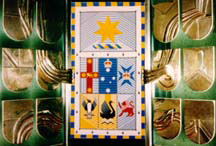 A woven tapestry in the form of a banner - 4.3 metres long and 2.5 metres wide - incorporates the badges of the States from the Shield of Arms of the Commonwealth surmounted by the Crest of the Commonwealth. It decorates the narrow but prominent wall adjacent to the bar table. It was woven in the Victorian Tapestry Workshop in South Melbourne.
A woven tapestry in the form of a banner - 4.3 metres long and 2.5 metres wide - incorporates the badges of the States from the Shield of Arms of the Commonwealth surmounted by the Crest of the Commonwealth. It decorates the narrow but prominent wall adjacent to the bar table. It was woven in the Victorian Tapestry Workshop in South Melbourne.
Doors for each of the three courtrooms incorporate a special design, those of Courtroom No. 1 featuring a silvered bronze grid partly recessed and fixed into the laminated plate glass. The theme of the design is a shield, emphasising the Court's function as a protector of the Constitution and the liberties of the citizen. The door handles continue the emblematic design.
Courtroom 2
 No. 2 Courtroom is described as the "Working Courtroom", as it is the venue for the majority of hearings. It is mostly used in cases where a full court of fewer than seven Justices is sitting. It has similar wall panelling and fittings to No. 1 Courtroom, although the ceiling is of painted moulded plywood.
No. 2 Courtroom is described as the "Working Courtroom", as it is the venue for the majority of hearings. It is mostly used in cases where a full court of fewer than seven Justices is sitting. It has similar wall panelling and fittings to No. 1 Courtroom, although the ceiling is of painted moulded plywood.
No. 2 Courtroom is also used for hearing applications for leave to appeal by video link. It therefore is fitted with special equipment for the transmission and reception of pictures and sound between the Courtroom and other cities in Australia.
Courtroom 3
 No. 3 Courtroom has been designed for cases which will be dealt with generally by a single Justice and is the smallest of the three courtrooms. It has a jury box so that a trial can be conducted on the rare occasions that such a case comes before the High Court. The Courtroom has been furnished with coachwood timber with a ceiling mainly of glass which provides a high level of natural lighting.
No. 3 Courtroom has been designed for cases which will be dealt with generally by a single Justice and is the smallest of the three courtrooms. It has a jury box so that a trial can be conducted on the rare occasions that such a case comes before the High Court. The Courtroom has been furnished with coachwood timber with a ceiling mainly of glass which provides a high level of natural lighting.
In Courtroom No. 1 are portraits of the first three Justices of the High Court. In Courtroom No. 2 the portraits of the second, third, fourth and fifth Chief Justices are displayed, and in Courtroom No. 3 are the portraits of the sixth, seventh, eighth and ninth Chief Justices.
Photographic portraits of all Chief Justices and Justices who have sat on the Court since its inception are displayed along the wall outside Courtroom No. 1.
The High Court of Australia is able to deal with cases which come to it on appeal or which begin in the High Court itself.
Cases which involve interpretation of the Constitution, or where the Court may be invited to depart from one of its previous decisions, or where the Court considers the principle of law involved to be one of major public importance, are normally determined by a full bench comprising all seven Justices if they are available to sit.
Other cases which come to the High Court for final determination involve appeals against the decisions of the Supreme Courts of the States and Territories, of the Federal Court of Australia and of the Family Court of Australia and these are dealt with by a full court of not less than two Justices. In addition there are certain matters which can be heard and determined by a single Justice.
The subject matter of the cases heard by the Court traverses the whole range of Australian law. It includes, for instance, arbitration, contract, company law, copyright, courts-martial, criminal law and procedure, tax law, insurance, personal injury, property law, family law, trade practices, etc.
Most of the Court's work relates to the hearing of appeals against decisions of other courts. There is no automatic right to have an appeal heard by the High Court and parties who wish to appeal must persuade the Court in a preliminary hearing that there are special reasons to cause the appeal to be heard. Decisions of the High Court on appeals are final. There are no further appeals once a matter has been decided by the High Court, and the decision is binding on all other courts throughout Australia.
Rules of Court, which are made by the Justices, set out the procedural steps that legal practitioners must comply with in preparing a case for hearing, including the preparation of an Appeal Book. The Appeal Book prepared by the appellant's legal practitioner, contains basic documentation which is necessary background for the Court to consider the issue raised by the appeal.
During the hearing, barristers representing the parties present their arguments orally to the Court.
This picture was taken in Courtroom 1 of the High Court in Canberra at the beginning of the hearing of the Work Choices case (State of New South Wales v Commonwealth of Australia, State of Western Australia v Commonwealth of Australia, State of South Australia v Commonwealth of Australia, State of Queensland v Commonwealth of Australia, Australian Workers Union & Another v Commonwealth of Australia, Unions NSW & Others v Commonwealth of Australia, State of Victoria v Commonwealth of Australia) on Thursday, 4 May 2006. It is noteworthy in that it involved the most number of counsel (39) ever to appear before the High Court in a case.
The Court rarely gives its decision (i.e. the judgment) at the end of a hearing. Rather, the decision is "reserved" and presented some time after the hearing. Each Justice makes his/her own decision on cases, and where decisions are not unanimous, the decision of the majority prevails.
The usual practice is for Justices to prepare written reasons for their decisions which are handed down by the Court at a later sitting. Printed copies of the judgments are given to the parties involved immediately after the decision is announced by the Court. The decisions are subsequently recorded in law reports and are now also available on computerised legal data bases.
Paper copies of judgments are available to the public, for a fee, by contacting one of the offices of the High Court Registry in Canberra, Sydney or Melbourne. Electronic copies of judgments are available at the AustLII site and other sites free of charge.
Decisions of the High Court are binding on all other courts throughout Australia.
- Beginnings
- The Great Depression and World War II
- Developments in Later Years
- Accommodation
- Sitting Practice
- Further Reading
Beginnings
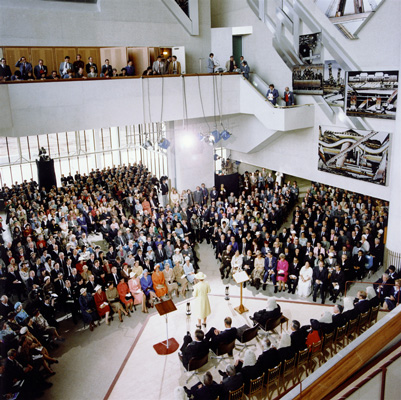 Although the High Court of Australia was established in 1901 by Section 71 of the Constitution, the appointment of the first Bench had to await the passage of the Judiciary Act in 1903.
Although the High Court of Australia was established in 1901 by Section 71 of the Constitution, the appointment of the first Bench had to await the passage of the Judiciary Act in 1903.
The first sitting of the High Court took place in the Banco Court of the Supreme Court building in Melbourne on 6 October 1903. It was a distinguished Bench, comprising three people who had been prominent in the Federal movement. They were:
- The Chief Justice, Sir Samuel Griffith, former Premier and former Chief Justice of Queensland.
- Sir Edmund Barton, the first Prime Minister of Australia and Leader of the Constitutional Conventions which led to Australia becoming a Federation in 1901.
- Richard Edward O'Connor, a former Minister of Justice and Solicitor-General of New South Wales and the first Leader of the Government in the Senate.
There was an opinion held by many at the time that the High Court would prove to be a redundant tribunal, with little work to do and no real status. However, the initial Bench quickly set about proving wrong these prophecies. From their first judgments, the Justices stamped the authority of the High Court over the State Supreme Courts and showed that the Court was a powerful and necessary arm of the newly-created Commonwealth of Australia. Using their own construct of the Constitution and the Judiciary Act, they took upon themselves a wide appellate jurisdiction, thereby increasing significantly the workload of the Court.
The Court quickly gained an international reputation for judicial excellence. Such was its success that the workload quickly became too much for three Justices. In 1906, the Justices made representations to parliament for an increase in their number. Later that same year, two more Justices were appointed - Sir Isaac Isaacs and Henry Bournes Higgins.
In November 1912 Justice O'Connor died in office. At the same time, the workload of the High Court had grown to the extent that it was stretching the capacity of five Justices, so Parliament agreed to again increase the Bench by two. In February 1913 Frank Gavan Duffy was appointed to replace Justice O'Connor, and the following month Charles Powers and Albert Bathurst Piddington were appointed to increase the High Court Bench to seven Justices.
Gavan Duffy's appointment was warmly welcomed by the legal profession but there was considerable disquiet about the appointment of Justices Powers and Piddington. Criticism centred around their abilities as lawyers: the Bars of New South Wales and Victoria even went so far as to withhold the customary congratulations on their appointment.
Justice Powers ignored the criticism and remained on the High Court Bench until 1929. Justice Piddington, however, resigned on 5 April 1913 without taking his seat on the Bench.
The Great Depression and World War II
In 1929 the Great Depression gripped the world. In July of that year Justice Powers retired, but the vacancy was not immediately filled. Then, in March 1930 Chief Justice Knox retired. Sir Isaac Isaacs was promoted to the position of Chief Justice, leaving a Bench of just five. The Great Depression had caused the workload of the High Court to decrease, and consequently there was a view in some areas of government that, in the interests of economy, the two vacancies on the High Court Bench should not be filled.
In December 1930, however, the Labor Government filled both vacancies. Doctor Herbert Vere Evatt was the first appointee. At age 36, he was, and remains to this day, the youngest person ever appointed a Justice of the High Court. The second appointee was Edward Aloysius McTiernan, who also set a record: he served on the Bench for almost 46 years, retiring in September 1976 at the age of 84.
In January 1931 Chief Justice Isaacs retired to take up his appointment as Governor-General. Sir Frank Gavan Duffy was promoted to Chief Justice but, due to the financial stringencies of the Great Depression, no appointment was made to restore the Bench to seven Justices. In 1933 Parliament amended the Judiciary Act which formalised the reduction in the number of Justices from seven to six. It wasn't until 1946 that, with the Great Depression and World War II over, the legislation was amended to restore the number of Justices to seven. The reasons given by the Government for the restoration were that the workload of the Court had increased and that the number of equally divided decisions was causing problems. Thus, in May 1946, Sir William Flood Webb was appointed to the Court. The Bench has remained at seven Justices ever since.
During World War II the High Court was called upon to determine many issues related to the extent of the Commonwealth's defence powers as prescribed in the Constitution. The results generally widened the Commonwealth's powers, in time of war or immediate threat of war, at the expense of the States. The situation was found to be different, however, during peace-time. In the famous "Communist Party Case" of 1951, for instance, the Court ruled invalid an attempt by the Parliament to invoke its defence powers (in light of the Korean conflict then in progress) to declare the Australian Communist Party an unlawful association.
Developments in later years
During the 1960's the appellate and original jurisdiction work of the High Court had grown to burdensome proportions. Sir Garfield Barwick, both as a Minister in federal Parliament (1958-1964) and as Chief Justice of the High Court (from 1964), proposed a new federal superior court to free the High Court from much of this work. The proposal grew in strength in subsequent years and, in 1976, legislation was passed establishing the Federal Court of Australia.
Appeals to the Privy Council from decisions of the High Court were effectively ended by the combined effects of the Privy Council (Limitation of Appeals) Act 1968 and the Privy Council (Appeals from the High Court) Act 1975. However, a right of appeal to the Privy Council remained from State courts, in matters governed by State law, until the passage of the Australia Acts, both State and Federal, in the 1980s.
In 1977 the Constitution Alteration (Retirement of Judges) Act was proclaimed, ending the life tenure of High Court Justices. The Act required that all Justices appointed from then on must retire on attaining the age of 70 years.
In 1979 the High Court was given the power to administer its own affairs by the passage of the High Court of Australia Act 1979. This Act, which was proclaimed on 21 April 1980, prescribes:
- The qualifications for, and method of appointment of, the Justices;
- The administration of the Court's affairs under the Act, including the appointment, functions and powers of certain Court officers;
- High Court Registry and procedure;
- Methods of funding and control of the Court's finances; and
- Reporting and accountability arrangements.
Accommodation
In its early years, the High Court shared courtroom and registry facilities with State courts in Sydney and Melbourne. Separate facilities were eventually provided for the High Court in Sydney in 1923. In Melbourne, a special building for the Court was constructed and opened in 1928. The Principal Registry of the High Court was located in these Melbourne premises until 1973, when it was transferred to Sydney.
A national competition for the design of a permanent home, in Canberra, for the High Court took place in 1972-73. Construction of the building began in 1975 and it was opened by Her Majesty the Queen on 26 May 1980. The Court and its Principal Registry were immediately transferred to the new building and the first sitting in this location took place in June 1980.
NOTE: more information on the High Court building may be found at the High Court building
Sitting practice
Today, most sittings take place in Canberra. Sittings are also scheduled in Sydney and Melbourne, usually on one day per month on an alternating basis. In addition, the Court continues the practice, established on its inauguration in 1903, of sitting in the capital cities of Queensland, South Australia, Western Australia and Tasmania once each year if there is sufficient business to warrant it.
Since 1989, the High Court has occasionally heard applications for special leave to appeal by video link with Brisbane, Adelaide and Perth. This method of hearing, which is designed to save litigants the cost of flying their counsel to Canberra, is becoming more and more popular.
Further reading
For those interested in reading more about the history of the High Court and its impact on Australian law, a selected list of books on those subjects is given below.
Bennett J.M, Keystone of the Federal Arch (Canberra 1980): AGPS
Blackshield, Tony, Coper, Michael and Williams, George (eds), The Oxford Companion to the High Court of Australia (Melbourne, 2001) Oxford University Press
Coper, Michael, Encounters with the Australian Constitution (North Ryde 1987): CCH
Deakin, Alfred, The Federal Story (Melbourne 1944): Melbourne University Press
Dixon, Sir Owen, Jesting Pilate (Melbourne 1965): Law Book Company
Else-Mitchell, Mr Justice, Essays on the Australian Constitution (Sydney 1961): Law Book Company
Galligan, Brian, Politics of the High Court (St Lucia 1987): University of Queensland Press
Howard, Colin, The Constitution, Power and Politics (Melbourne 1980): Fontana
Hull, Crispin, The High Court of Australia: Celebrating the Centenary 1903-2003 (Sydney, 2003) Thomson
La Nauze, J.A, The Making of the Australian Constitution (Melbourne 1972): Melbourne University Press
Lee, H. P. and Winterton, George (eds), Australian Constitutional Landmarks (Cambridge, 2003). University Press
Menzies, Sir Robert, Central Power in the Australian Commonwealth (2nd edn, Melbourne 1968): Cassell Australia Ltd
Sawer, Geoffrey, Australian Federal Politics and Law 1901-1929 (Carlton 1972): Melbourne University Press
Sawer, Geoffrey, Australian Federal Politics and Law 1929-1949 (Carlton 1974): Melbourne University Press
Solomon, David, The Political Impact of the High Court (Sydney 1992): Allen & Unwin
Zines, L. ed, The High Court and the Constitution (4th edn 1997): Butterworths

